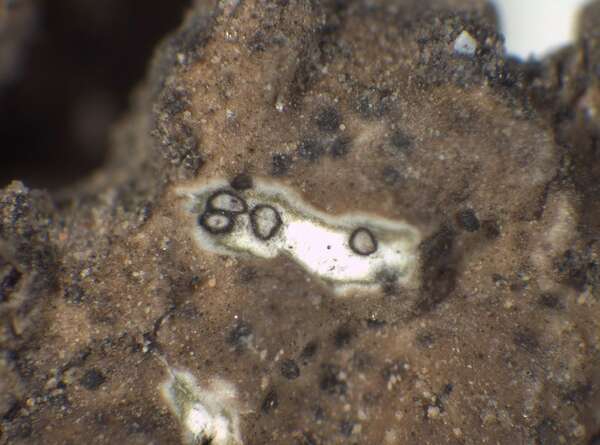Anthracocarpon virescens (Zahlbr.) Breuss
Ann. naturhist. Mus. Wien, 98B: 40, 1996. Basionym: Dermatocarpon virescens Zahlbr. - Österr. bot. Z., 68: 69, 1919.
Synonyms: Catapyrenium liratum Breuss; Catapyrenium virescens (Zahlbr.) Breuss; Clavascidium liratum (Breuss) Breuss
Distribution: S - Cal (Puntillo 1996).
Description: Thallus squamulose, cream-coloured to dark brown, the squamules 2-4(-5) mm broad, 0.18-0.33 mm thick, rounded to lobulate, flattened to slightly convex, smooth, scattered to contiguous, sometimes overlapping, developing on a dark hypothallus. Lower surface at first pale, but often blackening with age, attached by a mat of 2.5-5 μm thick, dark rhizohyphae and by up to 0.3 mm thick, 0.5-1.5 mm long, mostly simple, sparse, dark rhizines. Upper cortex paraplectenchymatous, 37-100 μm thick, of 6-15 μm wide cells, usually overlain by an up to 25 μm thick, continuous epinecral layer; medulla prosoplectenchymatous, of elongated cells; lower cortex absent. Perithecia frequent, laminal, pyriform to subglobose, totally or half immersed in the squamules, up to 0.5 mm wide, without involucrellum, with a 20-55 μm thick, carbonaceous, entire exciple of tangentially arranged, elongated cells; hamathecium of periphyses, interascal filaments absent. Asci 8-spored, narrowly clavate, the wall I-. Ascospores 1-celled, hyaline, thin-walled, very variable in shape and size, from ellipsoid to club-shaped, (13-)15-20(-23) x (5-)6-8(-9) μm. Pycnidia laminal, immersed, up to 200 μm wide, Endocarpon-type, consisting of a single cavity with an irregular contour with radially arranged conidiogenous cells. Conidia bacilliform, (5-)6-8(-9) x 1-1.5 μm. curved. Photobiont chlorococcoid. Spot tests: cortex and medulla K-, C-, KC-, P-, UV-. Chemistry: without lichen substances. Note: a mainly Mediterranean lichen growing in dry grasslands on calcareous substrata.
Growth form: Squamulose
Substrata: soil, terricolous mosses, and plant debris
Photobiont: green algae other than Trentepohlia
Reproductive strategy: mainly sexual
Commonnes-rarity: (info)
Alpine belt: absent
Subalpine belt: absent
Oromediterranean belt: absent
Montane belt: absent
Submediterranean belt: absent
Padanian area: absent
Humid submediterranean belt: very rare
Humid mediterranean belt: rare
Dry mediterranean belt: absent

Predictive model
Herbarium samples
Growth form: Squamulose
Substrata: soil, terricolous mosses, and plant debris
Photobiont: green algae other than Trentepohlia
Reproductive strategy: mainly sexual
Commonnes-rarity: (info)
Alpine belt: absent
Subalpine belt: absent
Oromediterranean belt: absent
Montane belt: absent
Submediterranean belt: absent
Padanian area: absent
Humid submediterranean belt: very rare
Humid mediterranean belt: rare
Dry mediterranean belt: absent

Predictive model
| Herbarium samples |
 INDEX FUNGORUM
INDEX FUNGORUM
 GBIF
GBIF





